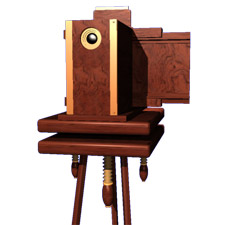"An Improvement in Photographic Camera." Patent no. 61, filed by W.A. Leggo, 1869
Patent no. 61. Filing year 1869.
"An Improvement on the Photographic Camera," W. A. Leggo.
William Leggo's camera, patented in August 1869, features the novelty of a sliding lens. The lens could be moved horizontally or vertically, enabling one to photograph tall or awkwardly sized objects without having to angle the camera, which Leggo claimed gave the picture "a strained and unnatural appearance." By keeping the camera square and moving just the lens, he wrote, "the effect… is that all the perpendicular lines of the picture retain their perpendicularity."
This camera patent capped a busy year for Leggo. Just a few months earlier, in June, he had patented his breakthrough invention. Combining his interest in photography with his background as a printer and an engraver, his halftone process revolutionized printing by enabling the reproduction of photographic images on the printed page. (Unfortunately, this patent was made before the opening of the Canadian Patent Office and therefore beyond the 1869 to 1894 range of the Made in Canada database.)
Leggo's productivity was encouraged by Georges-Édouard Desbarats, a businessman with whom he had formed a partnership in the mid-1860s. Leggo and Desbarats were kindred spirits who were excited by the possibilities of new printing technologies and the potential of photography. Desbarats, who had inherited his father's printing company in 1864, was well-versed in the technical aspects of printing and is sometimes co-credited for Leggo's inventions.
Their partnership soon produced two revolutionary patents. In 1865, Leggo patented Leggotype, a process to print line drawings on a page. It worked well for high-contrast pictures but couldn't reproduce shades of grey. At the time, photos posed a problem for printers: a printing plate made from a photograph and coated with ink would produce a smudged image on a page. Finding a way to accurately reproduce a photograph was the Holy Grail for printers.
A few years later, Leggo achieved this goal with his halftone screen. A piece of glass with a fine grid of lines etched onto it, the "screen" was placed in front of a photograph, which was photographed again. The screen's grid broke the continuous shades of the picture into thousands of tiny black dots; smaller dots in one part of the new photo gave the impression of a lighter shade of grey, while larger dots corresponded to a darker shade. On the resulting printing plate, this "simplified" image could be inked and printed successfully.
The first halftone image in a publication appeared in the first issue of the Canadian Illustrated News, founded by Desbarats, in 1869. Leggo and Desbarats made a bigger splash in launching The New York Daily Graphic in 1873, the world's first illustrated daily.
At this point, however, Desbarats was financially overextended, having invested an estimated $250,000 in the development of leggotyping alone. As a result, Desbarats was forced to pull out of the venture and rebuild his business in Canada, ending his productive (if expensive) partnership with Leggo. In 1879, Leggo withdrew from printing and moved to Lachute, Quebec, where he continued to file patents for various interests, including telegraphy.
References
Carpenter, Thomas. Inventors: Profiles in Canadian Genius. Camden East, Ont.: Camden House Publishing, 1990.
Dansereau, Bernard. "Leggo, William Augustus." Dictionary of Canadian Biography Online.
www.biographi.ca/EN/ShowBio.asp?BioId=41646&query;=leggo
(accessed October 10, 2005).
Galarneau, Claude. "Desbarats, Georges-Édouard." Dictionary of Canadian Biography Online.
www.biographi.ca/EN/ShowBio.asp?BioId=40183&query;=desbarats
(accessed October 10, 2005).
Phillipson, Donald J.C. "Desbarats, Georges-Édouard." Historica: The Canadian Encyclopedia.
http://thecanadianencyclopedia.com/index.cfm?PgNm=TCE&Params;=A1ARTA0002240
(accessed October 10, 2005).


